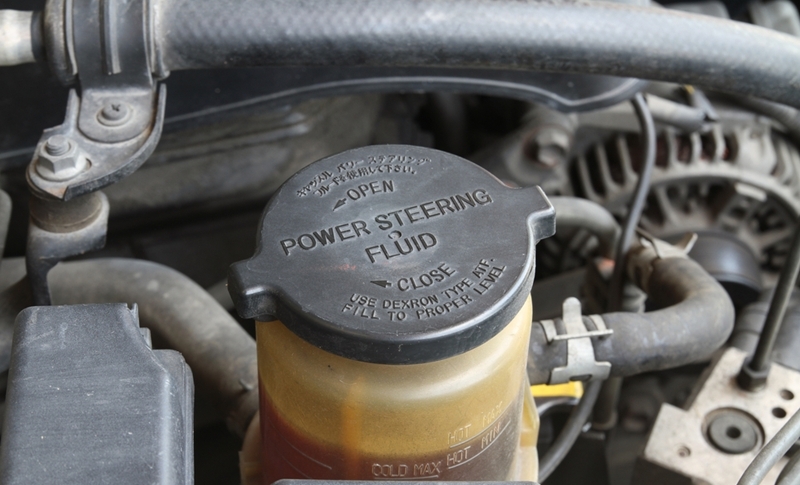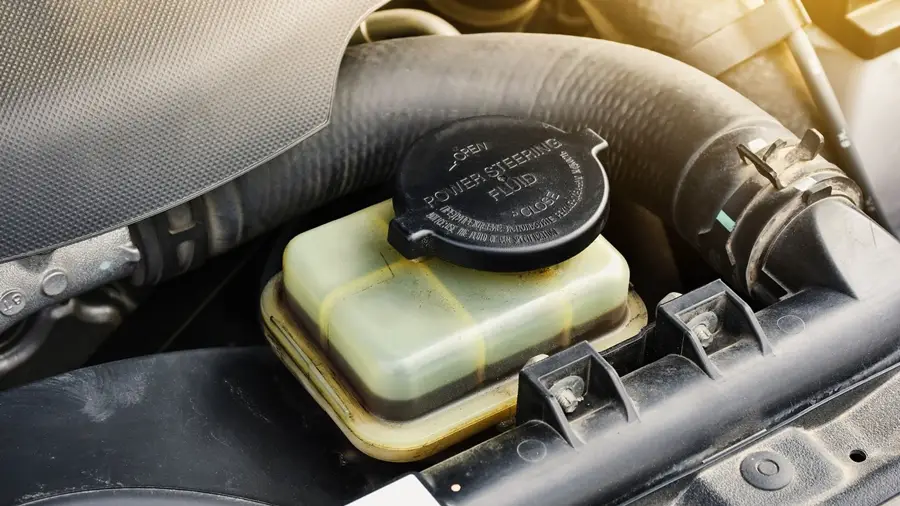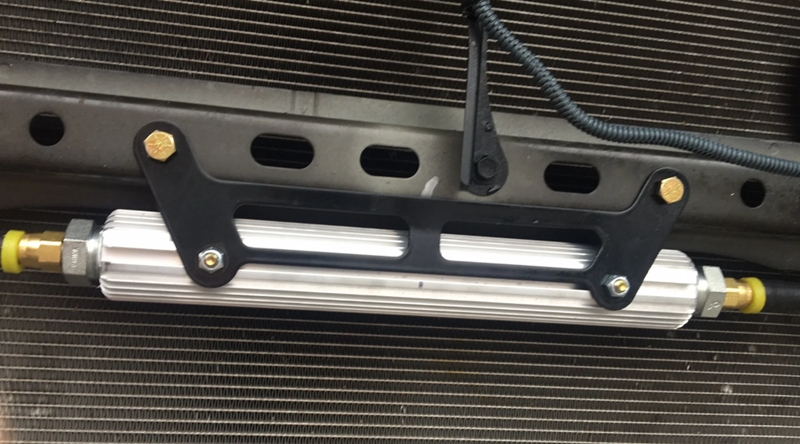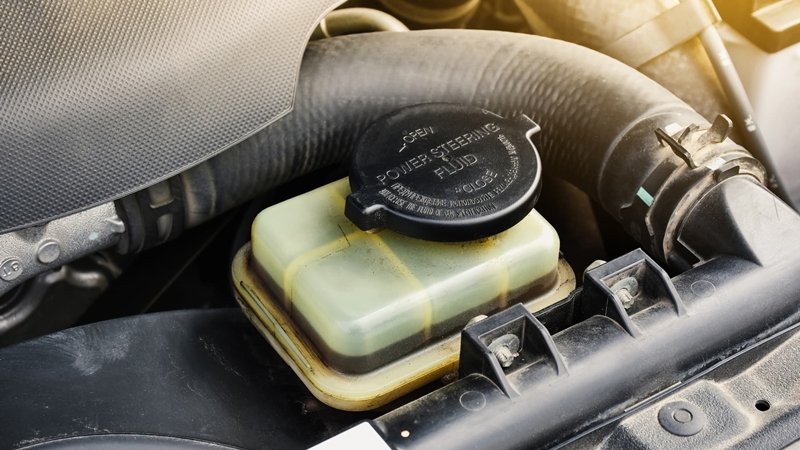Intro to Power Steering Leak Cost
Power steering is one of those essentials in modern cars that makes driving much easier. But if your steering wheel feels less responsive, or if you hear unusual sounds, it could indicate a power steering oil leak. Ignoring it might turn a simple fix into a wallet-draining repair. In this article, you’ll learn how to spot, repair, and budget for power steering fluid leak repair costs.
Table of Contents
Key Takeaways: Power Steering Oil Leaks
- Early detection is crucial. Watch for signs like fluid puddles, stiff steering, and whining noises.
- Leaks have many causes. Worn seals, damaged hoses, faulty reservoirs, and pump issues are common culprits.
- DIY fixes are possible. Minor issues like hose replacement can be handled at home with minimal tools.
- Professional help may be best. For major leaks or system damage, a mechanic ensures safe and thorough repairs.
- Costs vary. DIY fixes may cost under $100, while professional repairs can range from $150 to $800 or more.
- Don’t delay repairs. Ignoring a power steering oil leak can lead to serious safety risks and expensive damage.
- Preventative maintenance matters. Regular checks and using quality parts can help you avoid leaks altogether.
Understanding Power Steering Fluid
Power steering fluid is critical for your vehicle’s steering system, allowing you to steer with little effort. This fluid plays an essential role in the functionality of your steering system, and when there’s a power steering fluid leak, everything can go sideways—literally.
When you turn the steering wheel, the power steering pump sends fluid from the reservoir to the steering gear. Over time, this fluid can wear out or leak, and a power steering fluid leak can cause issues like difficult steering or noisy turns. According to industry reports, nearly 20% of vehicle steering complaints stem from low fluid levels due to leaks—often unnoticed until it’s too late.

In addition to enabling smooth steering, power steering fluid lubricates internal parts, reducing friction and wear. It’s a hydraulic fluid, which means it efficiently transmits force. But once contaminated or degraded—often the result of a slow power steering fluid leak—it can cause severe wear on steering components and might even lead to complete steering failure. That’s why regular checks and maintenance are crucial to avoid the headache (and cost) of a full system replacement.
Identifying Power Steering Oil Leaks
Detecting a power steering oil leak early is crucial if you want to save both money and time. Addressing leaks before they escalate prevents costly repairs and ensures your steering stays buttery smooth—just the way it should be. Here are some signs that you might be dealing with a power steering fluid leak:
Early Warning Signs of a Power Steering Fluid Leak
- Fluid spots under the car
Reddish or pink oily puddles near the front wheels. - Whining or squeaking sounds
Especially when turning the steering wheel. - Stiff or hard-to-turn steering wheel
Steering feels heavy or unresponsive. - Frequently low fluid levels
Having to top off the reservoir more often than usual. - Worn or cracked hoses
Visible damage, bulging, or leaks around hose connections.

Puddle or Spot Under Your Car
One of the most obvious red flags is spotting a dark, oily puddle under your car. This often points directly to a hydraulic fluid leak. The fluid is usually red or pink and tends to show up near the front of your vehicle, where the steering system is located. Over time, it may darken, making it harder to spot—so keep an eye out for any mystery puddles.
Squeaking or Whining Noises
Unusual noises—especially whining or squeaking when turning—can signal that your power steering pump is struggling. A common culprit? A steering fluid leak. When fluid levels drop, the pump has to work harder, which increases wear and risks pump failure if ignored.
Stiff Steering Wheel
Does your steering wheel suddenly feel like a gym workout? A stiff or unresponsive wheel often points to low fluid levels caused by a hydraulic fluid leak. Not only is this uncomfortable, but it also poses a serious safety risk—especially when quick steering is needed.
Low Fluid Level
Checking your fluid levels regularly is one of the easiest ways to catch a power steering oil leak before it becomes a bigger issue. If you find yourself topping off the reservoir often, there’s likely a leak somewhere in the system. Discoloration or debris in the fluid is another red flag that shouldn’t be ignored.
Worn or Damaged Hoses
Sometimes, the root of a power steering oil leak is as simple as a cracked or damaged hose. These rubber components wear out over time, especially under heat and pressure. Regular inspection and timely replacement of worn hoses can save you from major steering issues down the road.

What Causes a Power Steering Oil Leak?
Understanding what causes a power steering oil leak can help you address the issue quickly and prevent further damage to your steering system. A leak may seem small at first, but it can lead to reduced performance, increased component wear, and expensive repairs if left unchecked. Let’s break down the common culprits:
Worn Seals
The rubber seals inside the steering system are essential for keeping fluid contained. Over time, these seals can degrade from heat, age, or chemical exposure, leading to—you guessed it—a power steering oil leak. Regular checks can help you catch worn seals before too much fluid is lost.
Faulty Hoses
Power steering hoses transport fluid between the pump, reservoir, and steering gear. These hoses, often made from rubber, can crack or break due to high pressure, extreme heat, or simple wear and tear. When they fail, a power steering oil leak is almost guaranteed. Inspect hoses regularly for signs of damage and replace them as needed.
Damaged Power Steering Reservoir
If your power steering reservoir is cracked or damaged, fluid can escape and cause a power steering oil leak. Impact from potholes or accidents can compromise the reservoir’s structure. A leaking reservoir not only lowers fluid levels but can also introduce contaminants into the system—compounding the problem.
Corroded Fittings
The metal fittings that connect various components in the system can corrode over time, especially in areas where salt is used on roads. Corroded fittings lead to loose connections and—you guessed it—another power steering oil leak. Replacing rusty fittings promptly helps prevent leaks and keeps your steering smooth.
Power Steering Pump Failure
When the power steering pump fails, fluid can leak directly from the pump housing or seals. A power steering oil leak from the pump not only lowers fluid levels but also reduces steering performance. Pump failure is often the result of prolonged wear or neglect, so timely maintenance is critical.
Should You Hire a Mechanic to Fix the Power Steering Oil Leak?
When faced with a power steering oil leak, the decision to hire a professional mechanic—or even a mobile mechanic—can be the smartest move for your vehicle’s long-term health. Power steering systems are complex and vital to your car’s handling, so even a minor leak deserves proper attention.
Expert Diagnosis
A trained mechanic can quickly identify the exact source of your power steering oil leak, and they’ll also check for any hidden issues. What seems like a minor leak could be a symptom of a bigger problem—like a failing pump or deteriorating seals. A proper diagnosis ensures that the real issue is addressed the first time, preventing repeat repairs and saving you money in the long run.
Complete Repairs
Professionals have the tools and experience needed to tackle every kind of power steering oil leak, from worn hoses to faulty reservoirs. They can replace the affected components efficiently and according to best practices. Their expertise ensures that your repair isn’t just temporary—it’s built to last.
Warranty Considerations
If your vehicle is still under warranty, letting a certified mechanic handle your power steering oil leak might be a requirement to keep that warranty intact. DIY repairs could void coverage, leading to even higher costs if another issue pops up later.
While it might be tempting to grab a wrench and fix that power steering oil leak yourself, calling in a pro often pays off. From precise diagnostics to warranty-safe repairs, a skilled mechanic can restore your steering system to top condition—and let you drive away with peace of mind.
Power Steering Fluid Leak Repair Cost
Knowing how much a power steering oil leak might set you back can help you budget smart and avoid surprises. Whether you’re thinking of a DIY fix or heading to the mechanic, the final bill depends on how severe the leak is, what parts need replacing, and how much labor is involved.

DIY Costs
Tackling a power steering oil leak yourself? Here’s what you’re likely to spend:
- Power Steering Fluid: Expect to pay $10–$20 per bottle.
- Replacement Hoses or Reservoir: These parts can range from $25 to $150, depending on your vehicle’s make and model.
If the leak is small and you’re handy with tools, this route might save you some cash.
Professional Repair Costs
Not into DIY? Professional help is a smart choice—especially for more complex power steering oil leak repairs. Here’s a typical cost breakdown:
- Labor Costs: Mechanics usually charge $75 to $200 per hour. Repairs often take 1 to 3 hours. Dealerships, especially those servicing luxury cars, may charge over $200/hour, sometimes reaching $400/hour.
- Parts Replacement: New parts can cost anywhere from $100 to $500, especially if the power steering pump needs replacing.
- Diagnostics Fee: Many shops charge $50 to $150 just to pinpoint the leak.
Total repair costs generally fall between $150 and $800, depending on the damage and who’s doing the job.
Power Steering Leak Survival Guide: Costs, Fixes & Prevention Tips
Struggling with steering issues or noticing a mysterious fluid leak? Don’t let a minor power steering problem turn into a major repair bill. This free, easy-to-read guide covers everything you need to know—early warning signs, repair cost breakdowns (DIY vs. mechanic), and smart maintenance tips to prevent future leaks. Download it now and stay in control behind the wheel.
7 Costly Power Steering Leak Mistakes Drivers Make (And How to Avoid Them)
1. Ignoring Early Warning Signs
Mistake: Dismissing noises, puddles, or stiff steering.
Avoid It: Learn the symptoms and act fast when they appear to prevent bigger issues.
2. Delaying Repairs Due to Cost
Mistake: Putting off repairs to save money in the short term.
Avoid It: Understand that small leaks often lead to bigger repairs—fix early to save overall.
3. Using the Wrong Power Steering Fluid
Mistake: Using a generic or incorrect fluid type.
Avoid It: Always check your vehicle’s manual and use the exact fluid type it recommends.
4. Skipping Regular Fluid Checks
Mistake: Forgetting to monitor power steering fluid levels.
Avoid It: Check monthly, especially if your car is older or you drive in harsh conditions.
5. Neglecting Worn Hoses and Seals
Mistake: Overlooking cracked or brittle hoses during routine checks.
Avoid It: Inspect hoses and seals regularly and replace them at the first sign of wear.
6. Attempting DIY Repairs Without Proper Knowledge
Mistake: Trying to fix a leak without tools or experience.
Avoid It: Know your limits—some repairs are better handled by a certified mechanic.
7. Not Considering Long-Term Damage
Mistake: Focusing only on the immediate leak, not the system damage it can cause.
Avoid It: Understand that a leaking system strains the pump, rack, and other parts—address root causes, not just symptoms.

Tips for Preventing Power Steering Oil Leaks
Prevention is key! You can often avoid a power steering oil leak altogether by following these tips:
- Inspect Regularly: Check fluid levels and look over hoses and fittings for signs of wear.
- Keep Up With Maintenance: Stick to your vehicle’s recommended service schedule.
- Use High-Quality Parts: Invest in good components—they last longer and perform better.
- Avoid Overloading: Extra weight strains your steering system.
- Drive Gently: Avoid sudden jerks, rough terrain, and harsh turns whenever possible.

Why You Should Fix a Power Steering Fluid Leak
Delaying a power steering fluid leak repair might seem like a money-saver, but it can quickly lead to bigger problems. Here’s why quick action matters:
- Safety Risk: Low fluid means harder steering, especially during tight turns or emergencies — increasing the chance of accidents.
- Costly Damage: Leaks can overwork and overheat the power steering pump, leading to expensive repairs or full system failure.
- Chain Reaction: One leak can stress other components, causing more breakdowns and a costly repair cycle.
Fixing the leak early keeps your car safe, prevents further damage, and saves money in the long run.
Frequently Asked Questions (FAQ) About Power Steering Oil Leaks
What causes a power steering oil leak?
A power steering oil leak can be caused by worn seals, cracked hoses, a damaged reservoir, or even a failing power steering pump. Over time, heat and pressure break down components, allowing fluid to escape.
How do I know if I have a power steering oil leak?
Common signs of a power steering oil leak include a puddle under the front of your car, whining noises when turning, stiff steering, and low fluid levels in the reservoir. Regular inspections can help catch these symptoms early.
Can I drive with a power steering oil leak?
Technically, you can drive with a power steering oil leak, but it’s not recommended. Low fluid levels can make steering difficult and dangerous, especially at low speeds or during sudden maneuvers. It’s best to fix the issue promptly.
How much does it cost to fix a power steering oil leak?
Fixing a power steering oil leak can cost anywhere from $150 to $800 depending on the severity. DIY repairs like replacing hoses may cost under $100, while professional repairs involving pump replacement and labor can cost significantly more.
Can I fix a power steering oil leak myself?
Yes, minor power steering oil leaks can be fixed at home if you’re comfortable with basic car maintenance. Replacing hoses or topping off fluid is doable for many DIYers. But for more serious leaks, it’s safer to see a mechanic.
What happens if I ignore a power steering oil leak?
Ignoring a power steering oil leak can lead to pump failure, increased steering difficulty, overheating, and even accidents. The longer the fluid runs low, the more strain you place on the steering system, leading to costly repairs.
How do I prevent a power steering oil leak?
To prevent a power steering oil leak, check your fluid levels regularly, inspect hoses for damage, and avoid rough driving. Following your vehicle’s maintenance schedule and using high-quality parts also helps extend the life of your steering system.
Need a mechanic? Find one on the Mobile Mechanic Directory
Final Thoughts: Power Steering Fluid Leak Cost
A power steering oil leak might seem small at first, but the longer you wait, the more it can cost—in time, money, and safety. Whether you roll up your sleeves for a DIY repair or turn to a pro, knowing what to expect helps you make better decisions. Staying on top of maintenance and tackling leaks early ensures your steering stays smooth and reliable.
In the end, a responsive steering wheel isn’t just a comfort—it’s a crucial part of staying safe behind the wheel.





